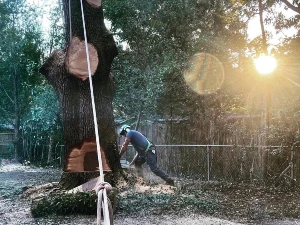
When a storm strikes or an unexpected event occurs, the trees on your property can quickly become a significant hazard. Whether it’s a tree that has been damaged by high winds, a heavy branch hanging precariously over your home, or a tree that has fallen and blocked access to your driveway, emergency tree removal is a critical service to restore safety and prevent further damage. In this article, we’ll explore the importance of emergency tree removal, the process involved, and how to choose the right service to handle the job quickly and efficiently.
Emergency tree removal becomes necessary when a tree poses an immediate risk to people, property, or access routes. This situation can arise from several causes, and understanding these causes can help you recognize when to seek professional help.
Severe weather, including hurricanes, tornadoes, thunderstorms, and ice storms, can wreak havoc on trees. High winds can snap branches or uproot entire trees, while heavy rain can saturate the ground, weakening root systems. After a storm, it’s common to find trees that are leaning, have split trunks, or have large branches hanging by a thread.
Trees that are already compromised due to disease, decay, or pest infestations are more likely to fail in an emergency. These trees may show signs of weakness, such as dead or dying branches, cavities in the trunk, or fungal growth. When a tree’s structural integrity is compromised, it can become a danger during adverse weather conditions or even on calm days.
Accidents, such as vehicle collisions with trees or construction-related damage, can also necessitate emergency tree removal. A tree that has been struck by a vehicle, for example, might be destabilized and could fall unexpectedly. Similarly, construction activities that damage a tree’s roots or trunk can lead to an emergency situation.
When faced with a tree that poses a danger, delaying removal can have serious consequences. Understanding these risks underscores the importance of prompt action.
A damaged or unstable tree can fall without warning, posing a severe risk to anyone nearby. This is particularly concerning in residential areas, parks, or public spaces where people may be walking, playing, or working.
Trees that fall or drop large branches can cause extensive damage to homes, vehicles, fences, and other structures. The cost of repairing this damage often far exceeds the cost of emergency tree removal.
In some cases, a fallen tree can block driveways, roads, or walkways, creating an immediate hazard and preventing access to your home or emergency services. This can be particularly dangerous if the tree is blocking a main road or access to a critical facility.
Emergency tree removal is a complex process that requires specialized skills, equipment, and experience. Here’s an overview of what you can expect when you call for emergency tree removal services.
The first step in the emergency tree removal process is a thorough assessment by a certified arborist or tree removal expert. They will evaluate the situation to determine the best course of action, considering factors such as the tree’s condition, location, and the immediate risks it poses.
Safety is paramount during emergency tree removal. The tree removal team will implement a range of safety measures to protect both the workers and your property.
The method used to remove the tree will depend on the tree’s size, location, and condition. Common techniques include:
After the tree has been safely removed, the debris will be cleared from your property. This may include:
Holston Tree Service handles everything from trimming to removals — with safety, compliance, and customer satisfaction guaranteed.
Selecting the right emergency tree removal service is crucial to ensuring that the job is done safely and effectively. Here are some tips for choosing the best service for your needs:
Look for a tree removal service with extensive experience in handling emergency situations. The team should have certified arborists on staff and a proven track record of safely removing trees in a variety of conditions.
In an emergency, time is of the essence. Choose a tree removal service that offers 24/7 availability and can respond quickly to your call.
The tree removal service should have the necessary equipment to handle any emergency situation, including cranes, rigging systems, and safety gear.
Always choose a tree removal service that is fully insured and certified. This protects you from liability in the event of an accident and ensures that the work is carried out to the highest standards.
At Holston Tree Service, we understand the urgency and importance of emergency tree removal. Our team of certified arborists is available 24/7 to respond to your emergency needs, ensuring that your property is protected and that any hazardous trees are removed safely and efficiently. With years of experience and the latest equipment, we are equipped to handle even the most challenging tree removal situations.
Don’t wait until it’s too late—if you have a tree that poses a risk, contact Holston Tree Service today. We are committed to providing prompt, professional service to keep your property safe and secure in any situation.
Don’t wait until small problems become big (and expensive) ones. Trust the certified professionals at Holston Tree Service for safe, reliable, and affordable tree care in Pensacola and Northwest Florida.
Call us today at 850-572-9863 or request a free quote to schedule your tree service.
Mike Holston & Amanda Holston are the husband-and-wife team behind Holston Tree Service, serving Pensacola and Northwest Florida with expert tree removal, trimming, and storm cleanup.
Mike oversees operations and customer care, while Amanda is ISA TRAQ-Certified and an ISA Certified Arborist, bringing specialized training in Tree Risk Assessment and advanced pruning prescription plans to every project.
Proudly serving Pensacola, Cantonment, Gulf Breeze, Milton, Molino, Jay, and Pace with certified tree care and 24/7 emergency service.
